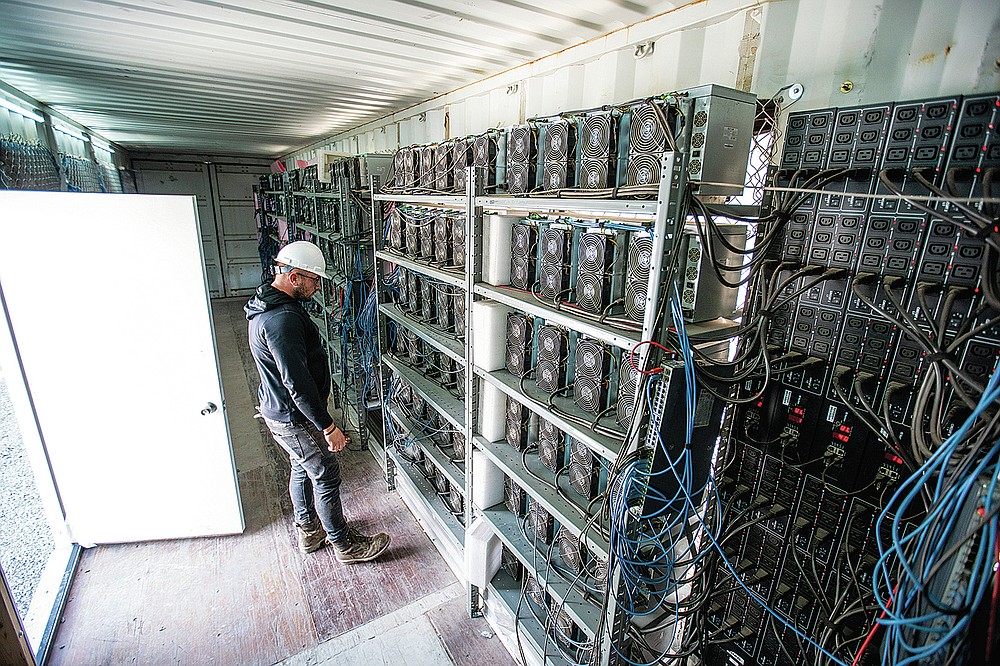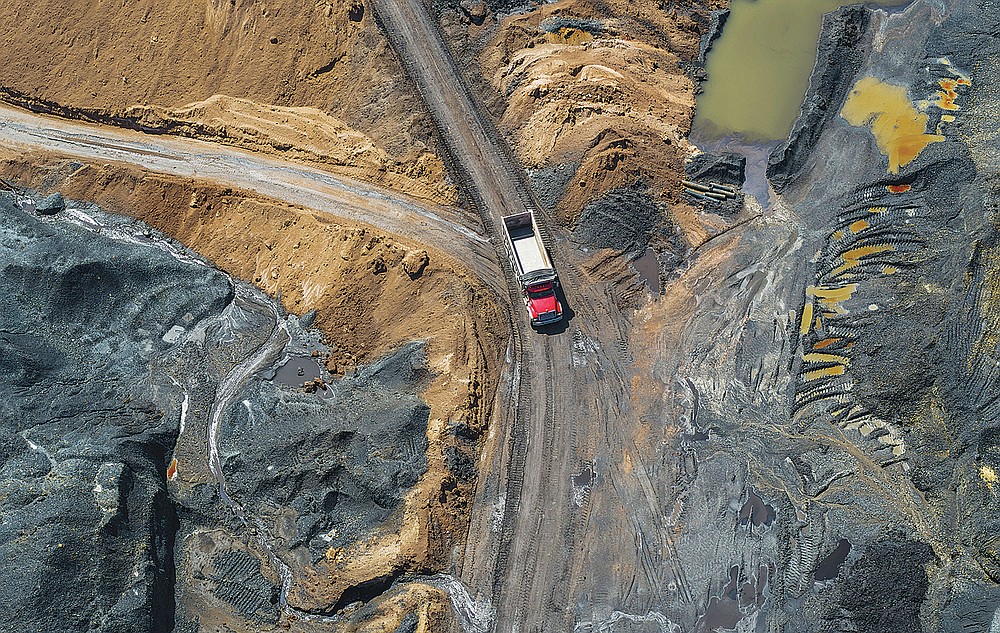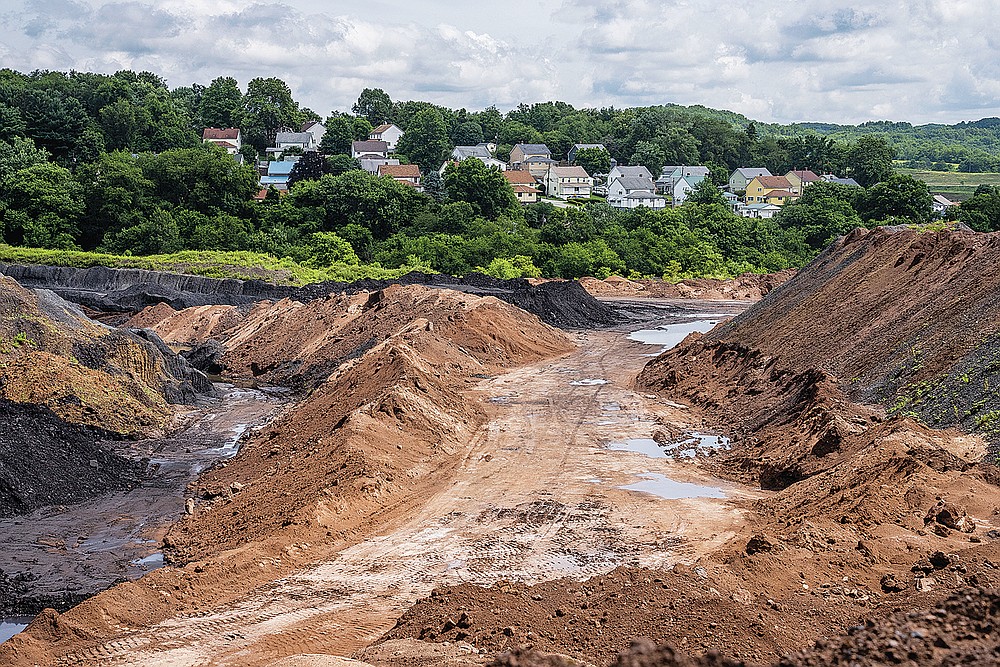[ad_1]
KENNERDELL, Pa. — In March 2017, Bill Spence got suddenly, catastrophically sick. A part of his pancreas died. His gall bladder failed. When he got to the emergency room, the doctors found kidney cancer. “Let’s see if you can make it 48 hours,” his doctor told him.
Just a few weeks earlier, Spence, a cheerful tower of a man whose signature ponytail had been updated to a gray man bun, had walked into the Scrubgrass waste coal plant that he had just bought and hung a black pirate flag in the office. The coal plant was a pirate ship, he announced. “We sink or profit together.”
The power plant and the mountains of waste coal that it burns were now in the hands of this group, not the large corporations and hedge funds that had owned it until then. Then, all of a sudden, the captain of the ship was on death’s door.
When Scrubgrass’ general manager, R.J. Shaffer, learned the news, he printed out a photo of the Venango County power plant and delivered it to Spence’s hospital bedside. The picture had two pirate flags, the signatures of the crew and was captioned: “The ‘Power’ of Healing.”
“I knew it would be an inspiration for him to get better,” Shaffer said.
And Spence did. The recovery left him homebound for several years, but it also left him with plenty of time to do what he does: come up with business ideas.
The plant he had bought was in trouble. It was competing with cheap natural gas on the power grid and losing — endangering the 35 jobs at Scrubgrass Generating Station along with the effort to clean up millions of tons of leaching coal waste left behind by mining companies over the course of decades.
The plant couldn’t just rely on the grid for revenue anymore, because the grid simply didn’t need its power all that often. Spence started to look for other customers.
As Spence convalesced, Shaffer and the plant’s engineering manager, Jeff Campbell, would visit with him in his Fox Chapel home to brainstorm ideas.
“Do you know what a Bitcoin is?” Spence asked them one day in late 2017.
COMPUTER ARMS RACE
Bitcoin is the most widespread of the cryptocurrencies in use today. These digital currencies, which involve a huge amount of computing power, aren’t issued by a central bank but are instead “mined” by computers that perform the energy-intensive work of validating transactions and adding them to a digital ledger, called the blockchain.
Just as mining coal or gold is a matter of who gets to the commodity first, so too is digital mining, where computers race against each other to be the first to validate a block of transactions and win their reward.
With each new computer vying for the prize, the algorithm adjusts to make getting it more difficult.
Rather like a coal company hiring more coal miners, crypto miners buy more and faster computers, creating a kind of arms race that’s driving a huge demand for power.
Already, some power generators — finding they can make more money supplying electricity to Bitcoin-mining operations than selling it to the grid — are shifting focus.
Energy Harbor, which owns the Beaver Valley Nuclear Plant in Beaver County, Pa., announced earlier this year that it will supply nuclear power to a Bitcoin-mining data center in Ohio.
Talen Energy, owner of the Susquehanna Steam Electric Station in Luzerne County, Pa., is doing the same. The company said recently that it will develop a data center to mine digital currency that could use up to 300 megawatts, or 12% of the nuclear plant’s capacity.
Bitcoin miners, in turn, are hyper-cognizant of power prices and availability.
Some are taking mobile units into the oil fields, hooking up their machines to run on natural gas, a byproduct of oil that would otherwise be flared. Others, worried about the substantial and growing carbon footprint of all this digital mining — Bitcoin’s highest profile booster Elon Musk recently called the industry to account for its contribution to climate change — are trying to find renewable sources of energy to power their machines.
THE PILES THAT REMAIN
Today, Scrubgrass, an 85-megawatt blue box with a black smokestack in the hills of Scrubgrass Township, looks much like it did when it first opened in 1993 — except for the trailers filled with Bitcoin miners in the back.
The operation originally came online along with a wave of such plants that were supposed to tackle Pennsylvania’s legacy of abandoned coal piles.
The plants took advantage of a new technology in the 1990s — a circulating fluidized bed that made it possible to burn such low-grade material and control emissions of sulfur and nitrous oxides. Limestone is injected into the process, and the resulting ash, now alkaline, is often spread on the land where the waste coal came from to neutralize the acid.
Last year, the Pennsylvania Department of Environmental Protection estimated there are about 9,000 acres filled with waste coal piles in the state remaining, after some 3,700 acres have been reclaimed over the past three decades, mostly by the piles being burned in waste coal power plants. Some piles are hundreds of feet deep.
“There is clearly more work to be done,” Department of Environmental Protection Secretary Patrick McDonnell told a state legislative committee last year during a hearing on the greenhouse gas impacts of such power plants. They emit more carbon dioxide than regular coal plants per unit of energy because the quality of their fuel is much lower than pure coal.
That has always been the trade-off — cleaning up the waste coal piles cleans up the water around them and remediates unsightly and dangerous land. But the CO2 goes in the air.
In 2019, the last year with available federal data, Scrubgrass emitted the equivalent of 371,000 tons of CO2 — the greenhouse gas footprint of 80,000 cars driving for a year. In 2012, when the plant was running at full force, it emitted close to a million tons.
The waste coal piles themselves also emit pollutants.
“Of the piles that remain,” McDonnell said last year, “approximately 40 have ignited and continually burn, significantly impacting local air quality and releasing significant amounts of carbon dioxide and other pollutants.” Other estimates put the number of burning piles at more than 90.
That’s why the Department of Environmental Protection essentially excused waste coal plants from buying carbon credits as part of its plan to join the Regional Greenhouse Gas Initiative, a multistate carbon cap-and-trade program.
THE PILES IN WEST DEER
It was another man’s illness, his father’s, that brought Spence into the waste coal business in the first place. A mining engineer from the Mon Valley, he was living in Texas in the early 1990s when his father got sick and Spence began to take extended trips to Pittsburgh to care for him.
Suddenly, the waste coal piles that he was used to seeing as a kid looked different — they looked like an opportunity.
In 1994, Spence bought a 5 million-ton gob — that is, garbage of bituminous — pile in West Deer and secured a contract with a brand new plant in Venango County to burn the waste coal.
It took a decade to truck all of that material 60 miles north to Scrubgrass. After it was burned, the resulting ash was trucked back to West Deer and spread on the land. There it sat compacting for another decade.
Stronghold Digital Mining’s initial public stock offering was filed with the Securities and Exchange Commission on July 27.
Earlier this month, Spence stood on that flattened ground in northern Allegheny County, now home to a pair of soccer fields and an indoor sports complex, and talked about what’s possible when waste coal is cleaned up.
Then he drove a quarter mile down the road, where a mountain range of abandoned coal waste showed how much is left to be done.
The other West Deer pile that now sends 50 trucks to Scrubgrass every day represents the remnants of a coal mine that once supplied steel to build U.S. skyscrapers and produce weapons during World War II. The mine opened in 1904 and shuttered eight decades later, leaving heaps of waste coal on the ground.
Every time it rains, the remnants leach an acidic brew of heavy metals into the earth, turning streams orange.
But it’s not the environmental good-doing that hooked investors during two funding rounds that yielded more than $100 million over the past several months.
The appeal was the Bitcoin operation, said Greg Beard, CEO and president of Stronghold Digital Mining, a company that he founded with Spence to turn Scrubgrass and several other waste coal plants into a crypto hub.
On a recent Tuesday, Stronghold filed documents with the Securities & Exchange Commission to become a public company.
‘IS THIS REAL?’
Jeff Campbell, the plant engineer, started researching Bitcoin as soon as he got home from Spence’s house in 2017. He watched a 40-minute YouTube video and said the idea clicked into place: “This is currency that’s underpinned by power.”
On Amazon, he bought a $50 USB stick that promised to mine Bitcoin. He switched his computer to an isolated network and plugged it in.
At that time, Bitcoin was still “fringe,” Campbell said, and he worried about getting a computer virus or even ending up on an FBI watchlist because of cryptocurrency’s reputation in moving funds for terrorism.
The USB stick worked as advertised, and after a few weeks, Campbell invested $1,000 and bought a mining machine, a computer whose sole purpose is to run computations. It ran for a week and generated the equivalent of $6.65 in Bitcoin.
Nervously, Campbell linked the machine’s digital wallet to Scrubgrass’ PNC account to transfer the spoils, then he went into the office to check if it really showed up there.
“Oh, my God. I can’t believe this is really going to work,” he said
“All we need to do is put 15,000 of these in,” he told Spence.
According to Campbell’s calculations, at that price, mining for Bitcoin with 15,000 machines would add about 50% to the plant’s operating revenue.
The earnings from the first machine funded the purchase of the second, then those two funded the third and so on.
Today, there are about 3,000 cryptocurrency miners packed into retrofitted shipping containers behind the power plant, most of them owned by Stronghold and some that belong to other mining companies that buy power from the plant. Another 5,000 machines are scheduled to arrive next month. According to documents filed with the SEC, Stronghold is planning to operate 57,000 miners by the end of next year.
In 2020, when the power plant seldom ran, Stronghold made more money from its Bitcoin operations than by selling Scrubgrass’s energy to the grid. During the first three months of this year, the trend reversed. It received almost $2 million from power sales and more than $1 million from its crypto data center.
Spence talks to his kids about blockchain, the cryptography involved in storing and verifying huge swaths of data, the way people in the 1960s talked about plastics, a la the movie “The Graduate.”
“I feel that blockchain is gonna change the world,” he said.
For Campbell it feels like the beginning of the internet did: He knows it’s going to be revolutionary and ubiquitous, but the vision is still fuzzy. “Facial recognition? Three-dimensional rendering? Autonomous driving? Artificial intelligence?” he spitballs.
Spence’s business partner, Beard, who used to manage energy investing at Apollo Global Management Inc., isn’t as exuberant.
“I’m not sure that you need to be a believer,” he said.
He plugged the numbers into an Excel spreadsheet and saw that it makes economic sense to mine. That was enough for him.
Stronghold is buying another waste coal plant, Panther Creek Energy Facility in Carbon County, with plans to replicate its cryptomining data center there and is eyeing a third.
STABILIZING THE GRID
While Bitcoin is the shiny veneer of the operation, it’s actually a means to an end — giving Scrubgrass a reason to run more than the electric grid needs so it can continue to burn waste coal.
For the first 20 years, the plant ran nearly constantly. It had a power purchase agreement with the local utility, which meant there was a guaranteed demand and a guaranteed price for its output.
When that ended, in 2013, Scrubgrass struggled to navigate the competitive power market, where the price of power was falling in part because the Marcellus Shale was making natural gas a cheaper fuel for electricity than coal, let alone waste coal.
Plants — especially smaller ones like Scrubgrass that find themselves on the margin — often run only at peak times when the demand on the grid raises prices enough to make it worth their while.
Having a constant demand, like the attached data center, means Scrubgrass doesn’t need to shut down when prices for power fall. It also means that when the grid needs it, Scrubgrass can act like a battery — instantly switching its power to the grid.
“I think 10 years from now, people are going to say, ‘Bitcoin is the thing that power plants do to regulate the grid,'” Campbell said.
He’s already thinking of ways to route the heat produced by the miners back into the power plant. (Last winter, Campbell heated his home with Bitcoin machines).
Meanwhile, the plant, although no spring chicken, feels like it’s still trying to figure out what it is — a place where people tinker and experiment. Shaffer, who spent most of his career at the plant, proudly proclaims that his colleagues aren’t “typical power plant people.” A former restaurant manager runs the data center.
Spence, not a typical anything except an entrepreneur whose ventures over the years ranged from natural gas services to a health magazine, hung the framed photo of Scrubgrass just inside the front door of his home.
“They should be building more plants like this, not less,” he said recently. “It’s not perfect. I acknowledge that to you. But it’s damn good.”

Chris Radwanski, data center supervisor, checks on bitcoin mining machines in a shipping container behind the Scrubgrass Power plant on Friday, July 23, 2021, in Russellton, Pa. (Andrew Rush/Pittsburgh Post-Gazette via AP)

A truck drives to pickup a load of material at a Russellton coal waste pile on Friday, July 23, 2021, in Russellton, Pa. The pile is being trucked to be used at the Scrubgrass Power plant in Venango County and later returned in the form of ash. (Andrew Rush/Pittsburgh Post-Gazette via AP)

Homes in a Russelton, Pa., neighborhood can be seen alongside a coal waste pile on Friday, July 23, 2021. The pile is being trucked to be used at the Scrubgrass Power plant in Venango County and later returned in the form of ash. (Andrew Rush/Pittsburgh Post-Gazette via AP)
[ad_2]


